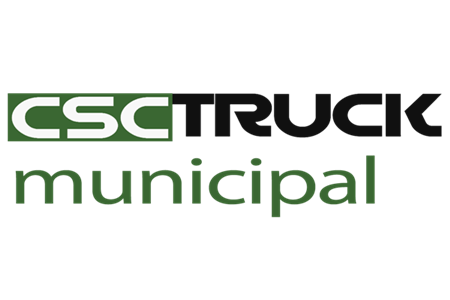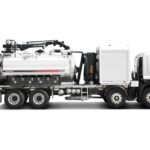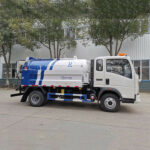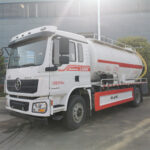Municipalities and utility companies face a constant battle against stubborn blockages—grease deposits, invasive roots, and sediment buildup—that threaten sewer system efficiency. Combo sewer jetter trucks have emerged as the ultimate solution, merging high-pressure water jetting with industrial-strength vacuum suction in a single, highly mobile unit. These advanced vehicles eliminate the need for multiple pieces of equipment, dramatically improving response times and operational efficiency for drain maintenance crews. This article explores the engineering behind these dual-function workhorses, their advantages over traditional methods, and their role in modern infrastructure maintenance alongside garbage trucks and sweeper trucks in keeping cities flowing smoothly.
1. The Dual-System Engineering Behind Combo Trucks
Unlike standalone jetter or vacuum trucks, combo sewer jetter trucks integrate both systems into a synchronized operation, allowing crews to clear and extract debris in a single pass.
High-Pressure Jetting System
The jetting component typically features:
- A 3,000–5,000 PSI water pump capable of scouring pipes from 2″ to 36″ in diameter
- Multi-angled nozzles that adjust spray patterns for cutting roots (0° forward jets) or flushing walls (40° rear jets)
- Heated water tanks (optional) to melt grease accumulations in cold climates
Cyclonic Vacuum System
The suction side complements jetting with:
- 1,200–2,800 CFM airflow to lift dislodged debris immediately
- Dual-stage filtration separating liquids from solids, with some models achieving 99% solids removal
- Hazardous gas detectors that automatically shut down suction if methane or H2S is detected
The key innovation lies in synchronization—jets blast blockages apart while vacuums simultaneously remove debris, preventing re-clogging downstream. This closed-loop process is 60% faster than using separate jetter and vacuum trucks.
2. Operational Advantages Over Traditional Methods
Cities transitioning from manual rodding or single-function trucks report dramatic improvements after deploying combo sewer jetter trucks:
Reduced Street Disruptions
- Single-vehicle operation means fewer parking space demands in crowded urban areas
- Faster job completion (30–90 minutes vs. 3+ hours for traditional methods) minimizes traffic lane closures
Enhanced Worker Safety
- No manual pipe entry required for most clogs
- Remote-controlled nozzles with live CCTV feedback reduce exposure to hazardous materials
- Integrated confined-space ventilation protects crews during manhole work
Cost and Resource Efficiency
- 50% less water usage compared to standalone jetters, as vacuums recover and filter water for reuse
- Lower fuel consumption than running separate jetter and vacuum trucks
- Extended pipe lifespan by avoiding the mechanical stress of rodding or root saws
These efficiencies explain why combo trucks now handle 70% of preventive maintenance in cities like Toronto and Melbourne, working in tandem with sweeper trucks that keep surface debris from entering drains in the first place.
3. Specialized Configurations for Unique Challenges
Not all blockages are created equal—leading manufacturers offer tailored combo truck setups:
Grease and Fatberg Removal
- Hot water systems (160°F+) melt solidified fats
- Auger attachments break up congealed masses before suction
- Bio-enzyme tanks pretreat lines to prevent re-accumulation
Root Intrusion Response
- Steel cable cutters integrated into jet nozzles
- Herbicide injection systems to slow regrowth (EPA-approved formulations only)
Industrial and Storm Drain Use
- Explosion-proof components for refineries/chemical plants
- Sediment traps handling 1-ton gravel loads common in storm systems
This adaptability makes combo trucks equally effective for routine maintenance and emergency responses, much like how garbage trucks vary configurations for residential vs. commercial waste collection.
4. Smart Technology Integration
Modern combo sewer jetter trucks are evolving into data-collection hubs:
Real-Time Diagnostics
- Sonar sensors measure remaining pipe wall thickness during cleaning
- AI blockage analysis compares CCTV footage to historical data, predicting future trouble spots
Precision Navigation
- Nozzle-mounted gyroscopes maintain optimal positioning in twisting pipes
- Automated reel systems that adjust hose speed based on resistance feedback
Fleet Synergy
- Shared GIS mapping with sweeper trucks to prioritize areas where street debris correlates with drain clogs
- Maintenance alerts routed to garbage truck crews when food waste dumping hotspots are identified
These technologies transform combo trucks from simple cleaners into proactive infrastructure guardians.
5. The Future of Combo Truck Innovations
Emerging advancements promise even greater capabilities:
Robotic Add-Ons
- Pipe-crawling drones that deploy from the truck to inspect lateral lines
- Self-propelled nozzles reaching 500+ feet without hose extensions
Green Upgrades
- Electric/hybrid powertrains reducing carbon footprints (already in pilot programs in Oslo and Seattle)
- Water recycling systems achieving 90% reuse rates
Cross-Fleet Integration
- Swappable modules that convert combo trucks into emergency pump units during floods
- Standardized data ports allowing garbage trucks and sweeper trucks to share real-time blockage reports
As urbanization intensifies and climate change stresses drainage systems, combo sewer jetter trucks will remain indispensable—not as standalone solutions, but as networked components of smarter, more resilient cities. Their ability to simultaneously clean and extract embodies the efficiency modern infrastructure demands, ensuring communities remain protected from the hidden crises brewing beneath their streets.







